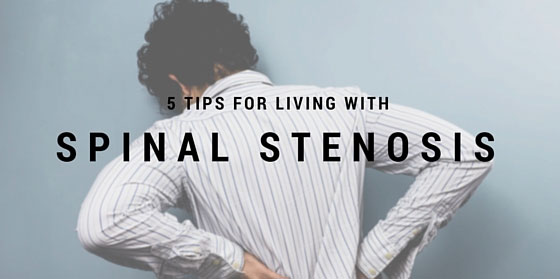5 tips for living with lumbar spinal stenosis
May 31By: Mark Blazek, Columbia Center
 Do you find yourself experiencing lower back or leg pain when walking or standing up tall? Does your back pain feel better when you lean on a shopping cart or your kitchen counter, or when you sit down? If you answered yes to one or more of these questions, it’s possible that you may be living with a condition known as lumbar spinal stenosis.
Do you find yourself experiencing lower back or leg pain when walking or standing up tall? Does your back pain feel better when you lean on a shopping cart or your kitchen counter, or when you sit down? If you answered yes to one or more of these questions, it’s possible that you may be living with a condition known as lumbar spinal stenosis.
This condition most often is caused by degenerative changes in the spine. A narrowing of the space within the spinal canal of the lower back results in less space for the nerves and blood vessels in the area.
This narrowing becomes more pronounced when extending the lumbar spine (bending backward, walking, or standing up straight, because it decreases the space surrounding the nerves) and can cause irritation. People living with this condition prefer bending forward because it gives their nerves more space.
Here are five tips if you or a loved one is living with stenosis:
- Understand the movements and postures that make your pain worse.
This really can make a difference and will help you plan and make accommodations when necessary. Typically, prolonged walking and standing will increase your pain. Timing exactly how long you are able to walk or stand before the onset of pain may be helpful information to have and can help you be prepared when you need to be.
- Develop strategies for managing situations where you are more at risk for developing pain.
Maybe you have to stand or walk for a duration that provokes your symptoms: attending a graduation, shopping, working on household chores. Try to incorporate seated rest breaks. If you cannot find a place to sit, look for a counter or podium to lean on. If that’s not an option, you can lean your back against a wall to find relief.
- Put everyday items in easy-to-reach places.
Reaching up to high shelves may require enough lumbar extension to irritate your symptoms. Place items that you use frequently, such as pots and pans, clothing, and cleaning supplies, in low-to-medium-height storage areas.
- Select appropriate physical activities.
Bike riding can be an excellent mode of exercise for people living with stenosis because it provides a position of relief. Pool exercises can be helpful as the water’s buoyancy can help to unload the spine and increase comfort.
- Talk to a physical therapist.
It can be challenging to deal with stenosis on your own. Physical therapists are experts at designing treatment programs to help you stay active.
If you or a loved one are having trouble staying active because of spinal stenosis, don’t wait.
